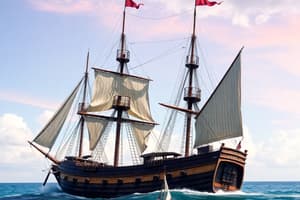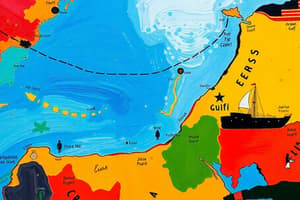Podcast
Questions and Answers
What was the basis of the Spanish empire in the New World?
What was the basis of the Spanish empire in the New World?
- Establishment of diplomatic relations
- Control of land and people (correct)
- Spread of Christianity
- Exploration of new trade routes
What was the impact of European diseases on the indigenous American population?
What was the impact of European diseases on the indigenous American population?
- Small decrease in population
- Up to 90% decrease in population (correct)
- No impact at all
- Moderate decrease in population
What was the role of Prince Henry of Portugal in European exploration and colonization?
What was the role of Prince Henry of Portugal in European exploration and colonization?
- He fought the Muslim merchants in the Indian Ocean
- He discovered the southern shore of the Mediterranean
- He funded and encouraged exploration and navigation study (correct)
- He led the Spanish empire in the New World
What was the basis of the Spanish empire's wealth in the New World?
What was the basis of the Spanish empire's wealth in the New World?
Who helped Francisco Pizarro take control of the Incan empire?
Who helped Francisco Pizarro take control of the Incan empire?
What was the impact of European diseases on the indigenous American population?
What was the impact of European diseases on the indigenous American population?
Flashcards are hidden until you start studying
Study Notes
European Exploration and Colonization
- Ottomans' capture of Constantinople in 1453 forced European kingdoms and empires to find new paths to Afroeurasian trading routes.
- Prince Henry of Portugal, known as The Navigator, funded and encouraged exploration, navigation study, and development of new tools.
- Portuguese explored the southern shore of the Mediterranean and ventured southward along the Atlantic coast of Africa.
- Portuguese traders kidnapped local people to sell into European slave markets and built stone fortresses that doubled as trading stations.
- European men partnered with African women who were traders and provided connections to trade.
- The Portuguese encountered a highly developed Indian Ocean commerce with trading posts run by sophisticated Muslim merchants and fought them to menace them.
- The Spanish empire was based on colonies, controlling the land and the people who lived there, and extracting wealth from them.
- Columbus, a student of geography and maps, found signs of gold but not great quantities of it, but he found people to enslave.
- The Spanish could now stock their new world settlements with Chinese and Indian luxuries by crossing the Pacific.
- Hernan Cortés came in contact with indigenous people, starting battles and forging alliances, and eventually reached the center of the Aztec empire at Tenochtitlan.
- Francisco Pizarro saw the superb textiles and silver and gold objects crafted by the Incas and relied on help from rival indigenous communities to take control.
- Violence, enslavement, and European diseases led to the death of perhaps as much as ninety percent of the indigenous American population.
European Exploration and Colonization
- Ottomans' capture of Constantinople in 1453 forced European kingdoms and empires to find new paths to Afroeurasian trading routes.
- Prince Henry of Portugal, known as The Navigator, funded and encouraged exploration, navigation study, and development of new tools.
- Portuguese explored the southern shore of the Mediterranean and ventured southward along the Atlantic coast of Africa.
- Portuguese traders kidnapped local people to sell into European slave markets and built stone fortresses that doubled as trading stations.
- European men partnered with African women who were traders and provided connections to trade.
- The Portuguese encountered a highly developed Indian Ocean commerce with trading posts run by sophisticated Muslim merchants and fought them to menace them.
- The Spanish empire was based on colonies, controlling the land and the people who lived there, and extracting wealth from them.
- Columbus, a student of geography and maps, found signs of gold but not great quantities of it, but he found people to enslave.
- The Spanish could now stock their new world settlements with Chinese and Indian luxuries by crossing the Pacific.
- Hernan Cortés came in contact with indigenous people, starting battles and forging alliances, and eventually reached the center of the Aztec empire at Tenochtitlan.
- Francisco Pizarro saw the superb textiles and silver and gold objects crafted by the Incas and relied on help from rival indigenous communities to take control.
- Violence, enslavement, and European diseases led to the death of perhaps as much as ninety percent of the indigenous American population.
Studying That Suits You
Use AI to generate personalized quizzes and flashcards to suit your learning preferences.




